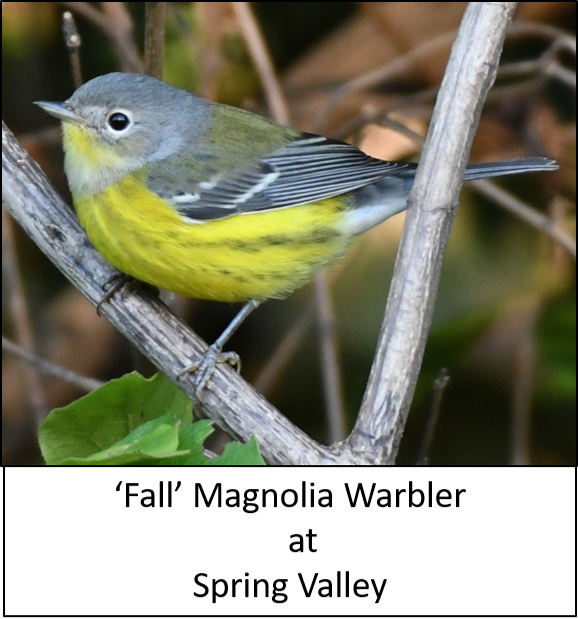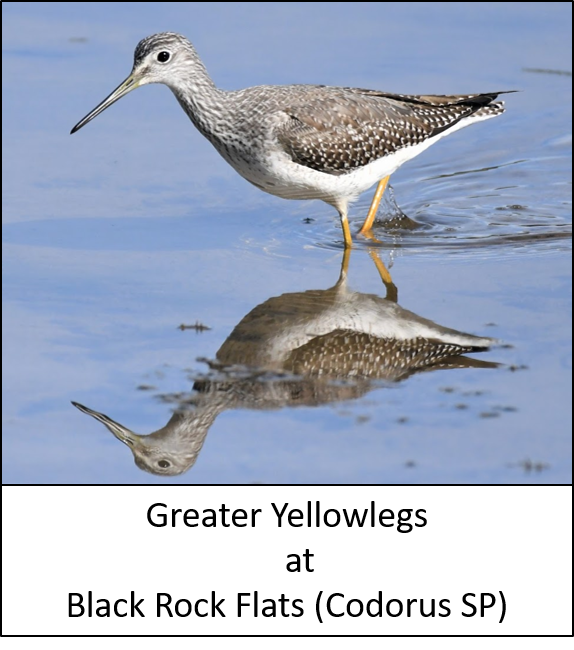Songbirds:
September marks the peak of fall migration. There are many things to be excited about in this month as the migration of neotropical songbirds, shorebirds, and raptors is all in full swing. If you’ve had those binoculars stashed away since May, this is the time to dust them off and get back out there! Warblers, Vireos, and Thrushes should be moving through in good numbers, so any good woodland habitat could produce exhilarating birding.
Songbird migration in the fall is quite different than it is in the spring. For one, the birds are not in as much of a hurry as they are in the spring, so the migration is more spread out over 6 weeks as opposed to the concentrated 3-week blitz in the spring. Also, since the birds are not worried about breeding and attracting mates, they are much, much less vocal in the fall. Another difference is their appearance. Many of the birds you will see in the fall are hatch year juveniles, which can often be tricky to identify as they usually have quite different plumage than the breeding males we are used to seeing in the spring. Even the adult males can be tricky to identify because their breeding plumage gets worn or even replaced by alternate plumage. Adult male Chestnut-Sided, Magnolia, Blackburnian, and Tennessee Warblers are virtually unrecognizable as the same species when compared to how they appear in the spring.
Another difference is that some species take a different route during the fall migration than in the spring. Two examples of this are the Connecticut Warbler and the Philadelphia Vireo. Both of these species take a more westerly route in the spring, but follow a route in the fall that goes through central PA. Your best chance of seeing the rare and elusive Connecticut Warbler is in September. Look for it in brushy areas such as the power line cut at Rocky Ridge. While the Philadelphia Vireo is rarely seen in the spring, it is much more commonly seen in the fall. Look for it in the woodland edge zones mixed in with warblers, especially at Spring Valley, Rocky Ridge, and Pinchot Parks.
September marks the peak of fall migration. There are many things to be excited about in this month as the migration of neotropical songbirds, shorebirds, and raptors is all in full swing. If you’ve had those binoculars stashed away since May, this is the time to dust them off and get back out there! Warblers, Vireos, and Thrushes should be moving through in good numbers, so any good woodland habitat could produce exhilarating birding.
Songbird migration in the fall is quite different than it is in the spring. For one, the birds are not in as much of a hurry as they are in the spring, so the migration is more spread out over 6 weeks as opposed to the concentrated 3-week blitz in the spring. Also, since the birds are not worried about breeding and attracting mates, they are much, much less vocal in the fall. Another difference is their appearance. Many of the birds you will see in the fall are hatch year juveniles, which can often be tricky to identify as they usually have quite different plumage than the breeding males we are used to seeing in the spring. Even the adult males can be tricky to identify because their breeding plumage gets worn or even replaced by alternate plumage. Adult male Chestnut-Sided, Magnolia, Blackburnian, and Tennessee Warblers are virtually unrecognizable as the same species when compared to how they appear in the spring.
Another difference is that some species take a different route during the fall migration than in the spring. Two examples of this are the Connecticut Warbler and the Philadelphia Vireo. Both of these species take a more westerly route in the spring, but follow a route in the fall that goes through central PA. Your best chance of seeing the rare and elusive Connecticut Warbler is in September. Look for it in brushy areas such as the power line cut at Rocky Ridge. While the Philadelphia Vireo is rarely seen in the spring, it is much more commonly seen in the fall. Look for it in the woodland edge zones mixed in with warblers, especially at Spring Valley, Rocky Ridge, and Pinchot Parks.
|
Shorebirds:
Shorebird migration hits full stride in September, so continue to monitor the water levels of the lakes in search of mudflats (see detailed description of mudflat locations in the August page). Look very closely at any birds seen, as rarities such as white-rumped sandpiper, dowitchers, or plovers will sometimes show up. You will also likely find Blue-winged Teal in these same areas as their movement through York peaks in September (much earlier than other waterfowl). Conditions change from month to month and year to year, so what was the hotspot for shorebirds in August may have dried up and no longer be good in September. Likewise, water that was too high in August in other areas may have receded to make great shorebird habitat now. Black Rock Flats is most consistently a shorebird hotspot this month, but conditions at nearby Long Arm and Shepperd-Myers should also be checked out. Lake Redman Boardwalk is always a good spot to keep an eye on. Pinchot Park can be good for shorebirds if the water level is especially low. |
Raptors:
Finally, migrating raptors are very much on the move in September. Broad-winged hawks can be seen by the hundreds on peak days during the second and third weeks of September. Along with the raptor parade seen from the RR Hawkwatch, the site provides a good opportunity to witness migrating Common Nighthawks and the aerial antics and vocal repertoire of the increasingly common Common Raven.
Visit the Hawk Watch at Rocky Ridge park where there are usually hawk-watch volunteers present at the platform from September until the beginning of November. The most productive times seem to be from 11 am to 3 pm on days with northeasterly winds.
|
|
Note: All pictures in this birding guide are actual pictures of birds taken while they were in York County, PA by David Arrow.




